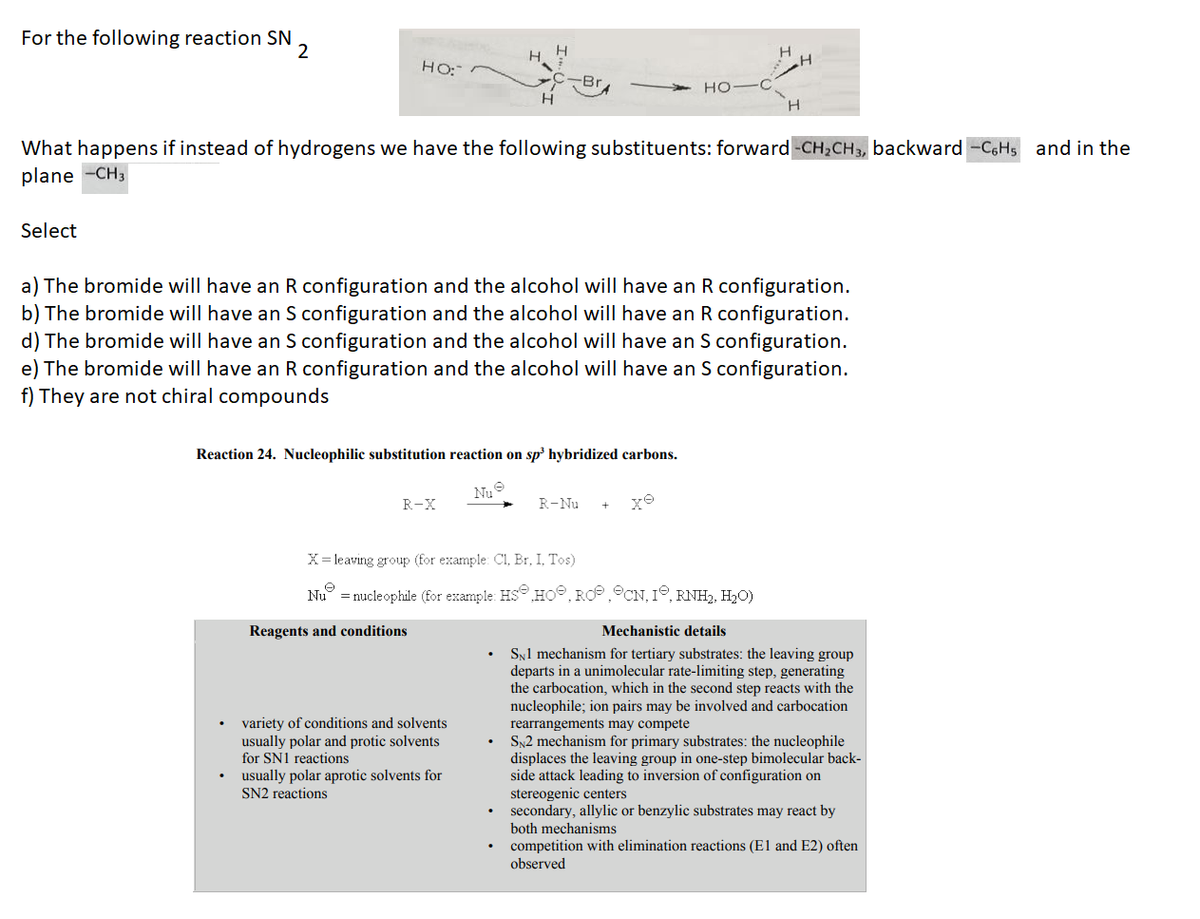For the following reaction SN 2 H H HO: HO H What happens if instead of hydrogens we have the following substituents: forward-CH₂CH3, backward -C6Hs and in the plane -CH3 Select a) The bromide will have an R configuration and the alcohol will have an R configuration. b) The bromide will have an S configuration and the alcohol will have an R configuration. d) The bromide will have an S configuration and the alcohol will have an S configuration. e) The bromide will have an R configuration and the alcohol will have an S configuration. f) They are not chiral compounds H
For the following reaction SN 2 H H HO: HO H What happens if instead of hydrogens we have the following substituents: forward-CH₂CH3, backward -C6Hs and in the plane -CH3 Select a) The bromide will have an R configuration and the alcohol will have an R configuration. b) The bromide will have an S configuration and the alcohol will have an R configuration. d) The bromide will have an S configuration and the alcohol will have an S configuration. e) The bromide will have an R configuration and the alcohol will have an S configuration. f) They are not chiral compounds H
Organic Chemistry: A Guided Inquiry
2nd Edition
ISBN:9780618974122
Author:Andrei Straumanis
Publisher:Andrei Straumanis
Chapter14: Elimination
Section: Chapter Questions
Problem 33E
Related questions
Question
100%

Transcribed Image Text:For the following reaction SN
2
HO:
HO-C
H
H
What happens if instead of hydrogens we have the following substituents: forward -CH₂CH3, backward -C6H5 and in the
plane -CH3
Select
a) The bromide will have an R configuration and the alcohol will have an R configuration.
b) The bromide will have an S configuration and the alcohol will have an R configuration.
d) The bromide will have an S configuration and the alcohol will have an S configuration.
e) The bromide will have an R configuration and the alcohol will have an S configuration.
f) They are not chiral compounds
Reaction 24. Nucleophilic substitution reaction on sp³ hybridized carbons.
Nu
R-X
R-Nu
X = leaving group (for example: Cl, Br, I, Tos)
Nu = nucleophile (for example: HS HO, RO, CN, 1°, RNH₂, H₂O)
Mechanistic details
SN1 mechanism for tertiary substrates: the leaving group
departs in a unimolecular rate-limiting step, generating
the carbocation, which in the second step reacts with the
nucleophile; ion pairs may be involved and carbocation
rearrangements may compete
SN2 mechanism for primary substrates: the nucleophile
displaces the leaving group in one-step bimolecular back-
side attack leading to inversion of configuration on
stereogenic centers
secondary, allylic or benzylic substrates may react by
both mechanisms
competition with elimination reactions (E1 and E2) often
observed
Reagents and conditions
variety of conditions and solvents
usually polar and protic solvents
for SN1 reactions
usually polar aprotic solvents for
SN2 reactions
H
H
H
H
Expert Solution
This question has been solved!
Explore an expertly crafted, step-by-step solution for a thorough understanding of key concepts.
This is a popular solution!
Trending now
This is a popular solution!
Step by step
Solved in 3 steps with 3 images

Knowledge Booster
Learn more about
Need a deep-dive on the concept behind this application? Look no further. Learn more about this topic, chemistry and related others by exploring similar questions and additional content below.Recommended textbooks for you

Organic Chemistry: A Guided Inquiry
Chemistry
ISBN:
9780618974122
Author:
Andrei Straumanis
Publisher:
Cengage Learning

Introduction to General, Organic and Biochemistry
Chemistry
ISBN:
9781285869759
Author:
Frederick A. Bettelheim, William H. Brown, Mary K. Campbell, Shawn O. Farrell, Omar Torres
Publisher:
Cengage Learning

Organic Chemistry
Chemistry
ISBN:
9781305580350
Author:
William H. Brown, Brent L. Iverson, Eric Anslyn, Christopher S. Foote
Publisher:
Cengage Learning

Organic Chemistry: A Guided Inquiry
Chemistry
ISBN:
9780618974122
Author:
Andrei Straumanis
Publisher:
Cengage Learning

Introduction to General, Organic and Biochemistry
Chemistry
ISBN:
9781285869759
Author:
Frederick A. Bettelheim, William H. Brown, Mary K. Campbell, Shawn O. Farrell, Omar Torres
Publisher:
Cengage Learning

Organic Chemistry
Chemistry
ISBN:
9781305580350
Author:
William H. Brown, Brent L. Iverson, Eric Anslyn, Christopher S. Foote
Publisher:
Cengage Learning
